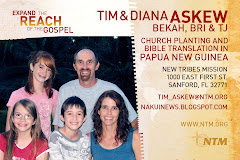Want to know why pioneer church planting in many tribal contexts takes so long? Despite our most well planned and valiant efforts, it seems like something ALWAYS comes up which hamper the expected results. This disappointing report doesn’t deal directly with Nakui church, but the ripple affect touches everyone in the Nakui tribe.
In an earlier posting I described how the VHV medical program holds out hope for the Nakui and many surrounding Sepik tribes to receive basic medical training as well as the necessary credentials to receive ongoing government subsidized medicine. What a deal, right? Finally gaining access to government services - always far beyond Nakui reach until this point - is about the biggest civic development for this society since, well … the discovery of saksak. Or at least that’s the way I, for one, think about it.
After successfully completing the six-week classroom coursework last fall (we paid to fly in and house the training personnel to put the course on at Iteri), all that remained was the practical training for our two students. Problem: the course can only be offered at a medical post about 30 miles and 3-days hike away in a neighboring tribe. Solution: the students hike together with other neighboring students to this location, arriving a day or two before the course begins. They all agreed this was doable (3-day hikes aren’t uncommon) and committed to being there.
What could possibly get in the way now? Finally … the down-and-out Nakui were poised and on the brink of taking a HUGE leap ahead! Their diplomas awaited them. They only need to show up and complete this short, two-week module. But it never happened. Dominik, the medical trainer, graduated students from a number of surrounding tribes, but there were no Nakui certificates handed out.
What happened? A brother of one of the Nakui students had stolen a shotgun from someone who lives in the area where the course was taking place. Fearful of what payback may come upon them, the day of departure they decided not to join the delegation of students. It was the resulting fear of this one man’s actions that held them back.
This is an ongoing theme in these remote tribes; the actions of one holding back the many. Over and over we’ve seen men, in a fit of rage, destroy community water tanks, medical clinic bug screen, and even a community outboard motor. What we work for years to establish can be reversed faster than a jungle sunset. It’s hard to say where we go from here. First we need to get back to Nakui and hear them out and see if there is a desire to fix this. There might be something we can all do about it, but next time it will probably cost them a whole lot more than just a 3-day hike. How bad will they want it?
News and stories about the Askew family ministry in Papua New Guinea
Welcome to our blog "The Nakui Jungle Beat". Just as Nakui people ring out an urgent message by rythmically hitting a hollowed out log or "Ow", we want to share an important message with you. What is our message? It is that through the grace of God, the Nakui people have found hope and meaning through the Gospel of Jesus Christ. We hope this tool will allow us to pass along the story of how God's grace continues to shine in this remote corner of the PNG jungle. Thanks for visiting!
Pics of Feb '10 Nakui Trip
Blog Archive
Askew Praise and Prayer
- Feb 9th: Well ... another broken bone in the Askew family. It's TJ again this time. He was up picking flowers in a tree and when a branch broke and he fell on his right shoulder. Besides some bruising, his shoulder seems fine. But his collar bone didn't fare so well and is fractured. We spoke with our doctor on the phone and doesn't think there's much he can do so we've got him in a sling and on pain meds and we'll let him heal up here in Wewak. Poor TJ is in a lot of pain tonight and it'll probably be a rough night's sleep. Thanks for your prayers.
New Askew Family Photo Card

Request to have one sent to you (use email address below)
Want to contact the Askews? Use this email address:
Back-to-English Version of Nakui Romans 3:23,24
"We are all people who do bad actions. We all live down below, our bad actions are many. Therefore not one person can go and live with God in heaven. We live like that, but listen, God had mercy on us. Truly, he helped us without repayment. He sent his Son Jesus Christ to us people of the ground, in order to purchase our sins. He purchased them and now He calls those of us who believe this his straight men and women."

